Gerard Moreno’s career hasn’t been as easy as other’s. He arrived at Villarreal aged just 18 but after playing for their C and B teams, he only managed to get 19 appearances for the first team before being loaned to Mallorca and then sold to Espanyol for just 1.5 million euros. He impressed at the Catalan side with 39 goals in 118 matches and Villarreal bought him back three years later for 20 million euros.
Since returning to his youth club, Moreno has been in excellent form, hitting his peak last season with 20 goals in 37 matches in all competitions. These performances won him his debut with Spain and he has six caps and three goals so far. In this tactical analysis, we will look at Moreno’s unique playing style that has taken him from the Spanish third tier to the National Team.
Player overview
Moreno is a left-footed attacker with decent size (180cm / 5’11’’) but not especially physical as he’s not very strong and lacks some acceleration when he’s completely stopped. He does have some change of pace once he’s moving and is well-coordinated, so his pace is good both on and off the ball. He also has good agility and can move well in tight spaces.
He usually plays between the lines or from the right side, with lots of freedom to move from side to side and up and down. Moreno tends to come to the right-wing or the right half-space and push his attacking teammates – usually Chukwueze and Alcácer – to central positions. Even when playing as a striker, he doesn’t run in behind very often, leaving that job to Alcácer. Moreno prefers to receive to his feet or make late runs into the box as he has quality and technique, excellent understanding of the game and goalscoring ability.
In his heatmap below we see he covers a lot of ground, especially on the right side of the pitch. With this positioning, it’s difficult to call him a striker, or at least he’s not a classical number nine.

Striker, midfielder or winger? His role in Villarreal’s attack
This season, Moreno is playing even closer to the right-wing than before. He has always been some kind of second striker who tended to come to the left to cut inside and use his best foot and this season he’s taking that position more than ever and pushing Chukwueze, a classical inverted winger, to the striker position.
He often starts as the right-winger, and even if he likes to come inside and play in the half-spaces, he still hugs the touchline when he has to, providing width and an option to switch the game. By doing this, Moreno helps his team to start new attacks with quick long balls when they have reached a dead-end on the left side.
In the next picture, we see an example of Moreno staying wide when the attack is happening on the other side of the pitch and receiving a long ball to his feet to start a new attack.
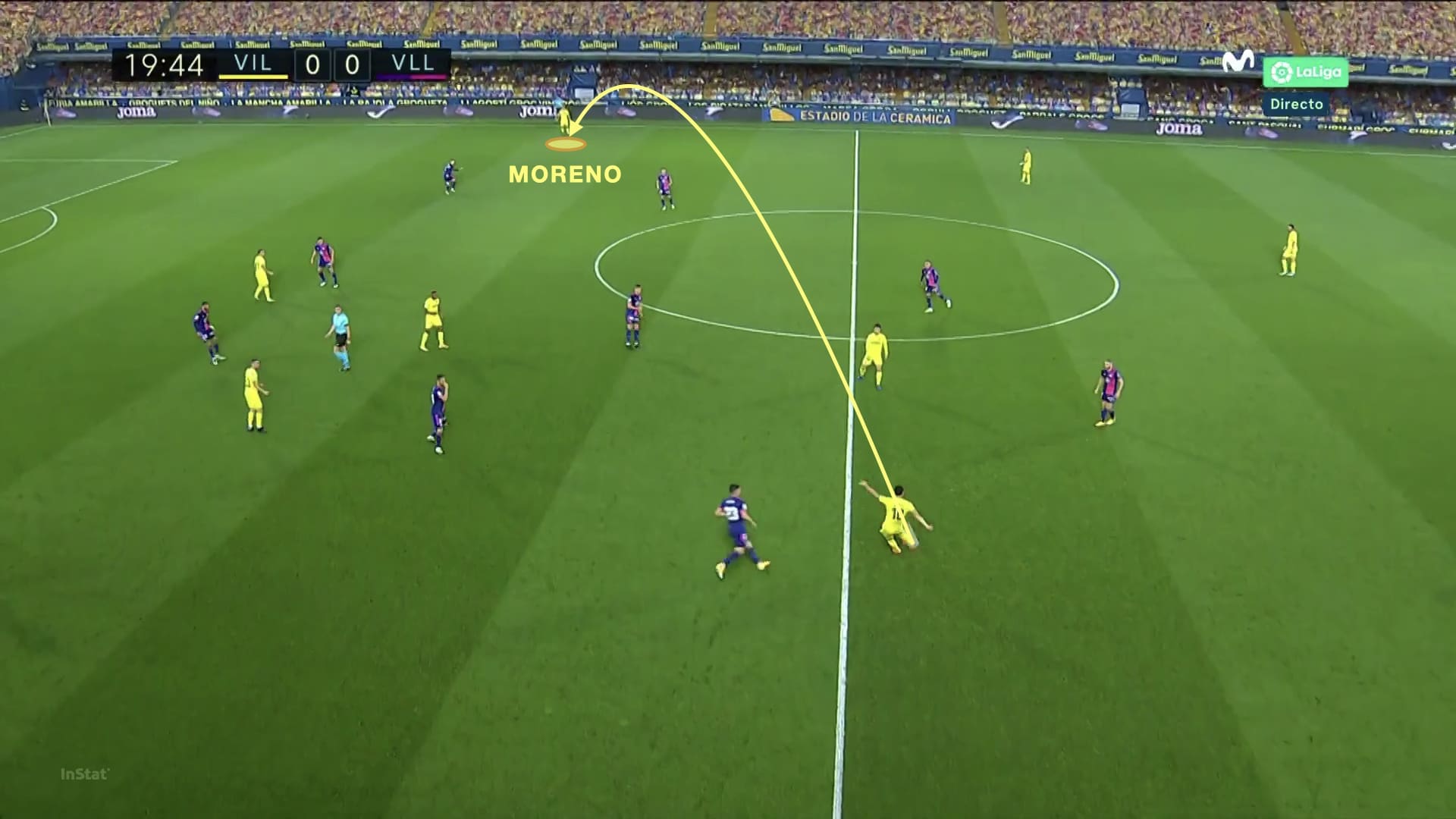
When the play is happening closer to his position, Moreno is very active near the midfield line, moving to create passing lanes and helping his team to progress from the back. He acts as an attacking midfielder, connecting his more defensive teammates with the forwards. Once he receives in the small pockets of spaces between the lines, Moreno reads the game very well and can turn or pass quickly, progressing with quick combinations or even assisting his teammates with accurate passes as we will see later in this analysis.
An example of what’s been said before can be seen below. In this play, Moreno gets in the half-space and between the lines between several Valladolid players to receive a pass from the centre-back. When the pass is coming, he spots the run of his teammate and lets the ball run between his legs and reach a better position. This shows not only his positioning to help his team progress, but also his vision and quality.
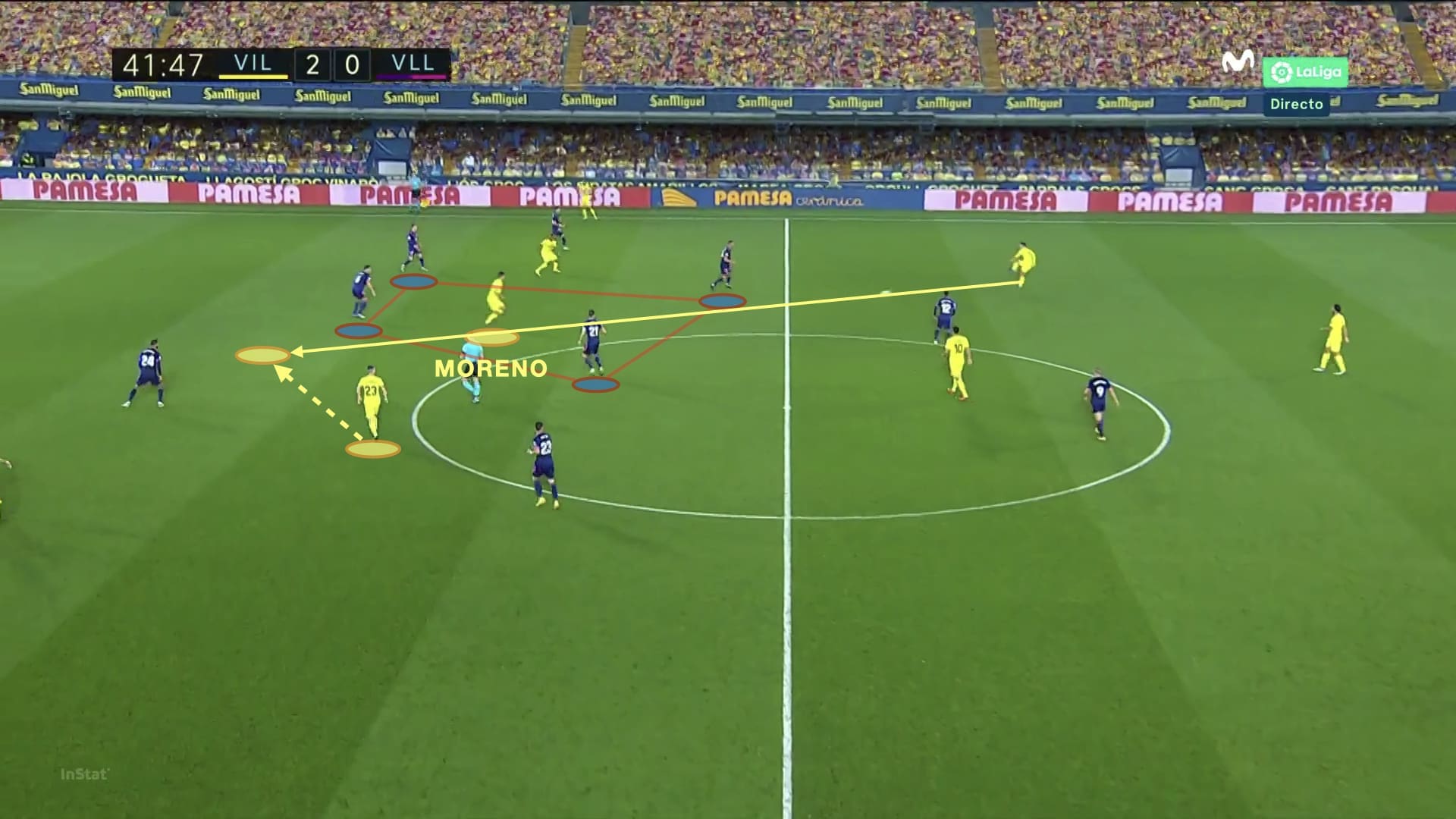
When he actually receives the ball, Moreno can make first-touch passes that help his team to establish in the opposition half. He combines these quick passes with dribbles or more aggressive passes, making him an unpredictable player when he receives the ball in these zones.
The next picture is an example of this quality to play first-touch passes. Again, Moreno gets himself between three rival players to receive the ball from a deeper teammate. Even if the rival left-back presses him quickly, Moreno plays a first-touch pass into the run of his right-back, leaving his rival out of play and his teammate with spaces to progress. This action not only requires intelligence, but also the technique to put the exact weight on the pass even under pressure.
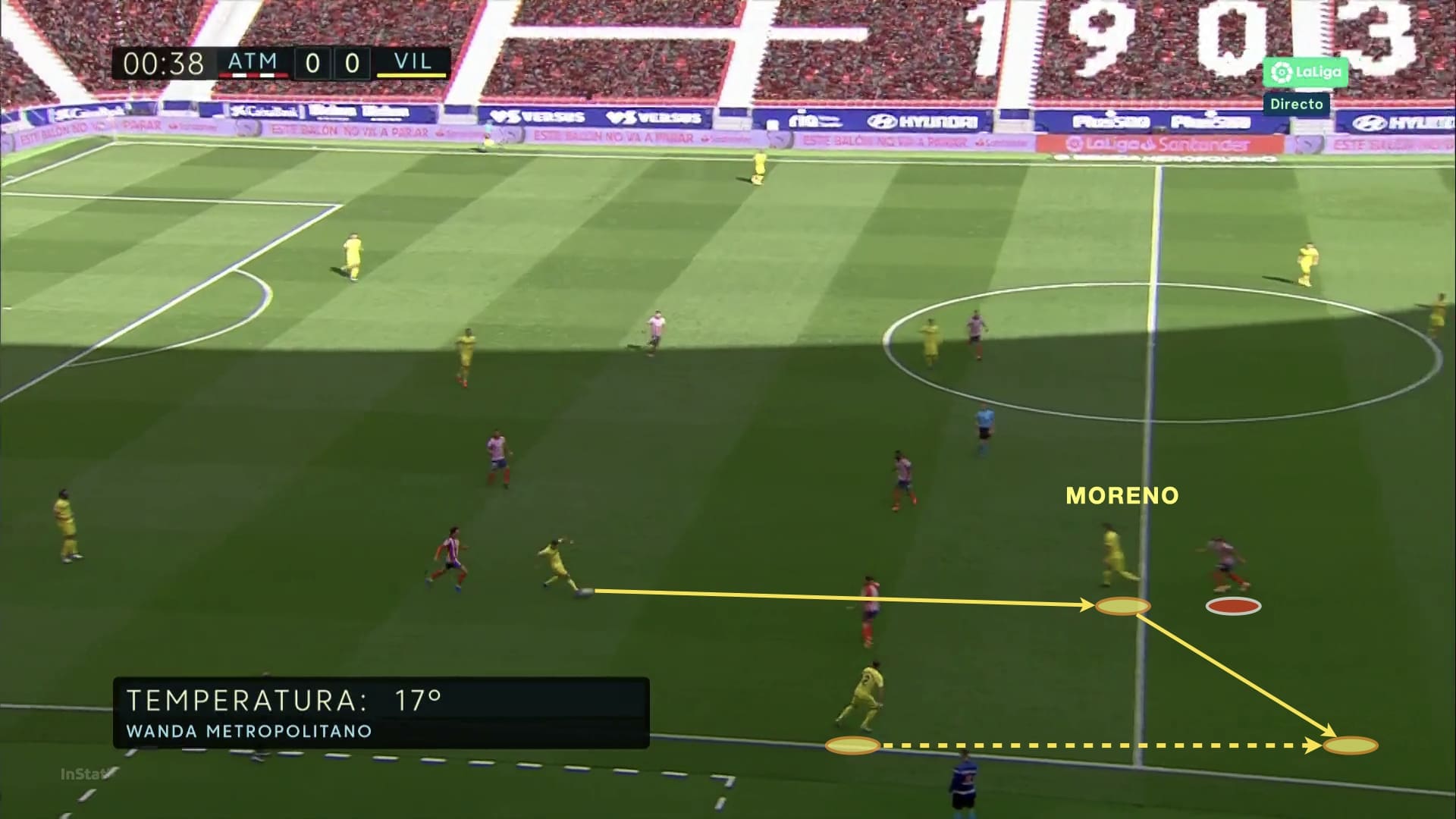
But apart from this ability to receive low passes between the lines, Moreno is also a good option in direct balls from the back. Even if he’s not very strong, his positioning and timing are very good, so he’s usually a yard apart from the defender when he receives the ball and he has the quality to control and hold it while he waits for his teammates. His first touch is especially good and helps him hold much bigger and stronger rivals. This ability to receive long balls can be seen in the statistics, as he’s the sixth attacking player (including forwards, wing-forwards and attacking midfielders) with the most long passes received per 90 this season with 3.48.
Finally, one of Moreno’s best traits is his quality in transitions and counterattacks. His excellent positioning opens passing lanes his teammates can take advantage of and when he receives the ball he can turn and launch the counterattack very quickly.
Below we see his actions in counterattacks in the last calendar year. We can see he can either start them with accelerations and passes or finish them with dribbles and shots. He’s an intuitive and intelligent player who knows what’s required in each play and has the quality and pace to make it happen.
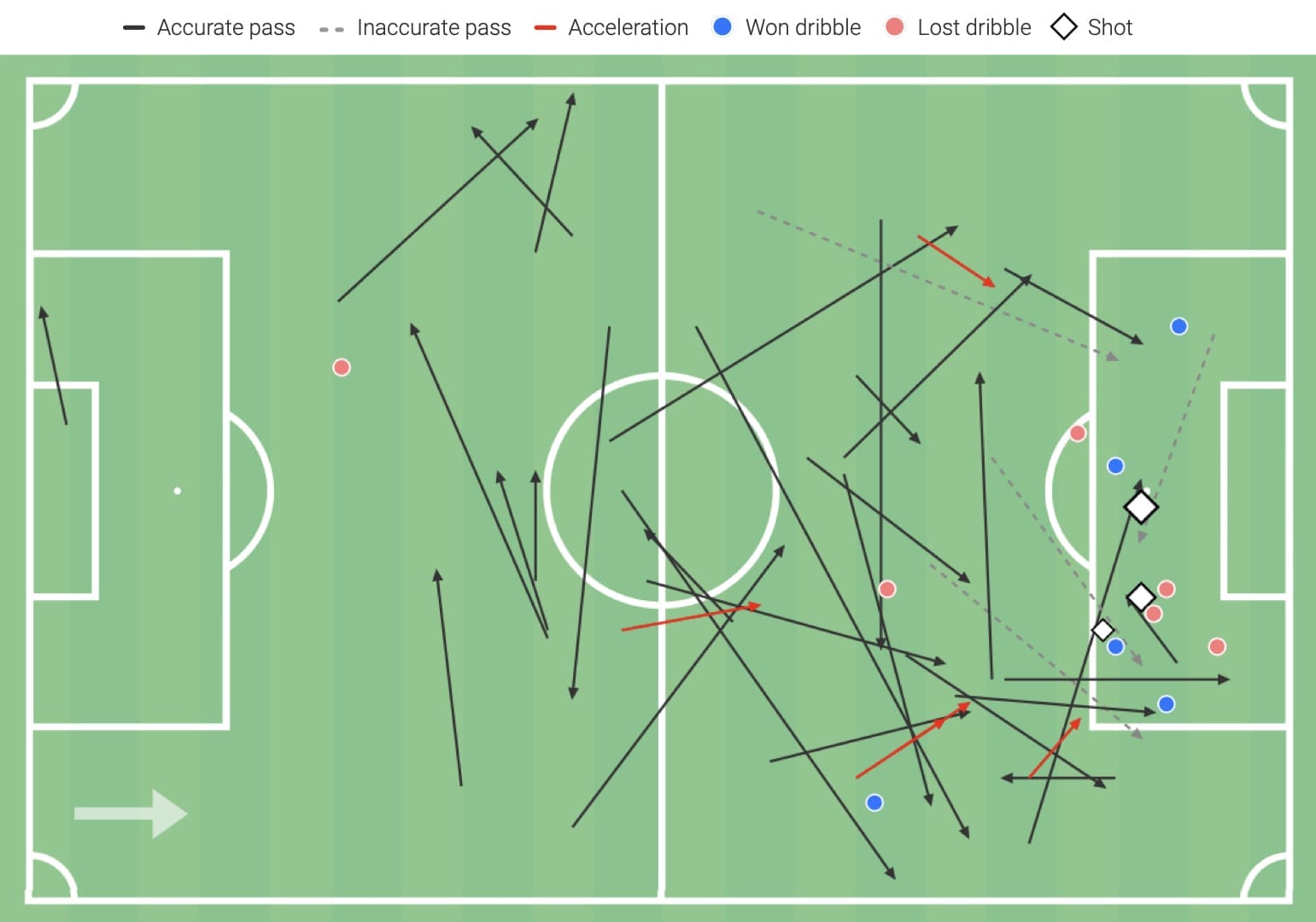
An important part of this threat in transitions comes from his first touch when he’s facing his goal. As we mentioned before in this scout report, Moreno is not the quickest when starting to run, so he uses body feints to send the defender the wrong way and turn with one simple touch. In the picture below we see the exact moment of one of these.
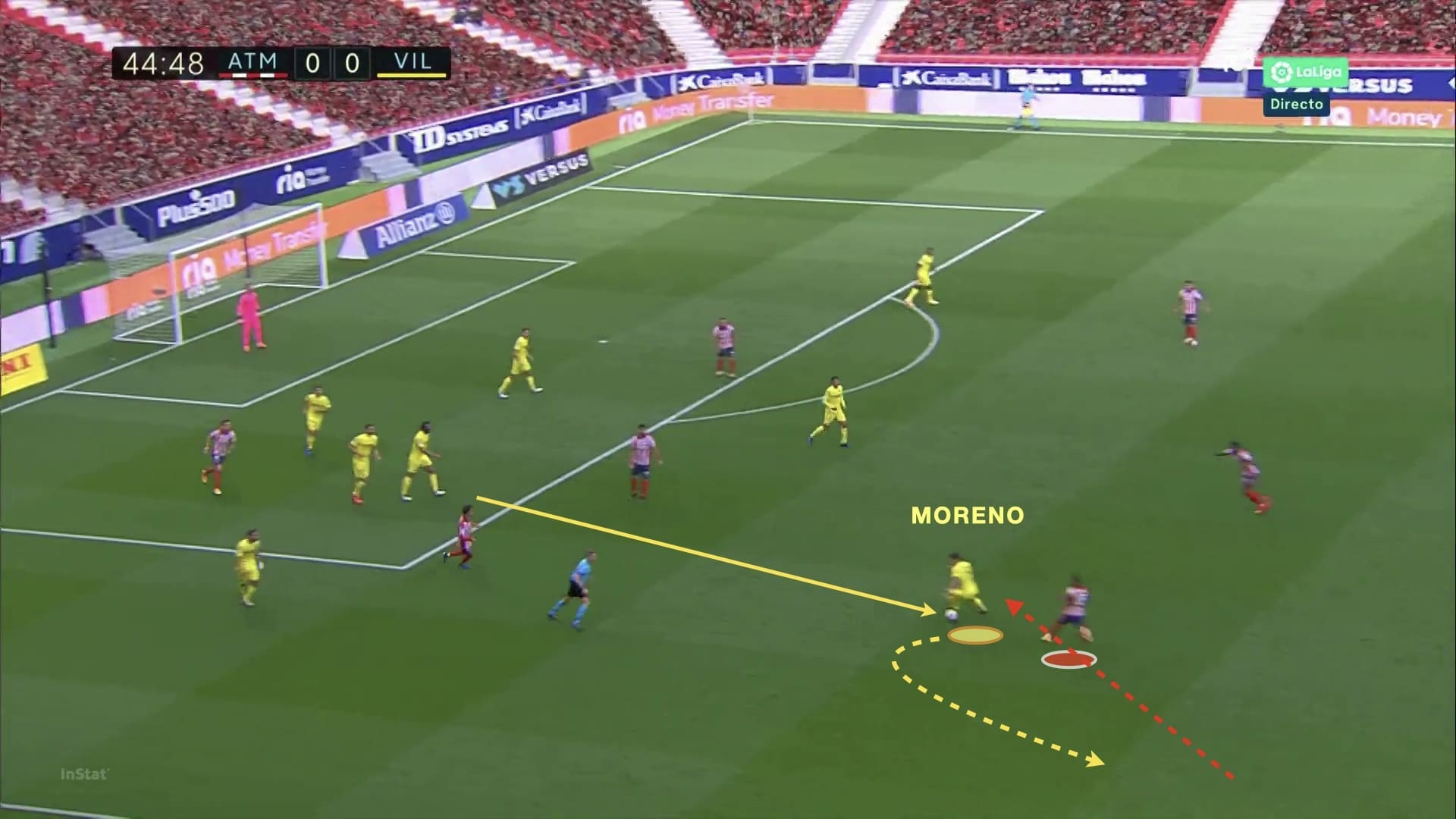
As a summary of this ability to progress the ball, let’s look at his ball-progression map from the last calendar year. Again, we see he can take the ball anywhere around the right side of the pitch and progress from there, mostly with passes but also with runs. Having a player with this vision plus his passing range and scoring instincts is a bless for Villarreal.
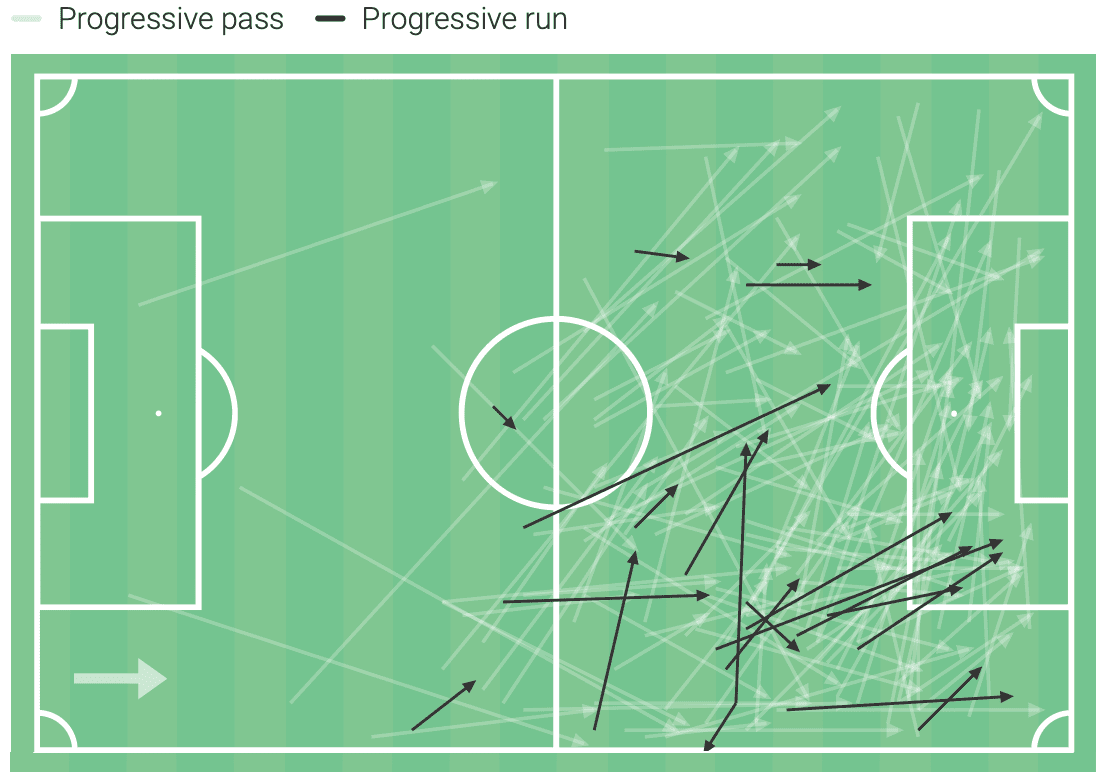
In this section of the tactical analysis, we have seen how important Moreno is for his team progression. He’s the sixth attacker in the league with the most passes per 90 with 37.96, pricing how involved and how important he is in his team’s tactics. He takes a variety of roles that impede us from telling if he’s a striker, a midfielder or a winger because he’s a mix of all that. The tactical intelligence the quality required to do this are very high, and Moreno has plenty of both of them to help Villarreal with his movements.
Final third contribution
When it comes to his contribution in the final third and in front of the goal, Moreno stands out as a fantastic player. Some players can help their teams in the distribution and progression like him, but few of them have the impact Moreno has in the final third.
Starting with his numbers, Moreno has scored 18 goals from 15.48 xG in the last calendar year, which is 0.48 goals and 0.39 xG per 90. He was the top Spanish scorer in La Liga, earning his first caps with the national team. But he’s good at creating chances. In the last calendar year, Moreno has registered 0.15 assists from 0.18 xA per 90. That means Moreno has been involved in 0.63 goals per 90, only slightly overperforming his 0.57 expected involvements per 90, which means he’s not having a lucky year or a hot streak and it could be maintained over time.
When we see how Moreno generated that, the first thing we notice is he thrives when his teammates take advantage of his movements. Coming deep to receive the ball and moving around the right-wing, Moreno generates spaces that players in all the lines can use. He needs the full-back to rush forward so he can create numerical advantages or pass him the ball, but also the forwards and midfielders to make runs in behind so he can assist them or use the spaces they generate to make late runs into the box.
At Villarreal, Emery has understood this and the rest of the player have clear instructions when Moreno receives the ball. We can see that in the next sequence. In this first picture, Moreno receives the ball between the lines in the right half-space, in one of the positions he likes the most as we have seen before in this tactical analysis. Mario Gaspar is already running the wing and Alcácer is positioned between the centre-backs, so no Alavés defender can press Moreno.
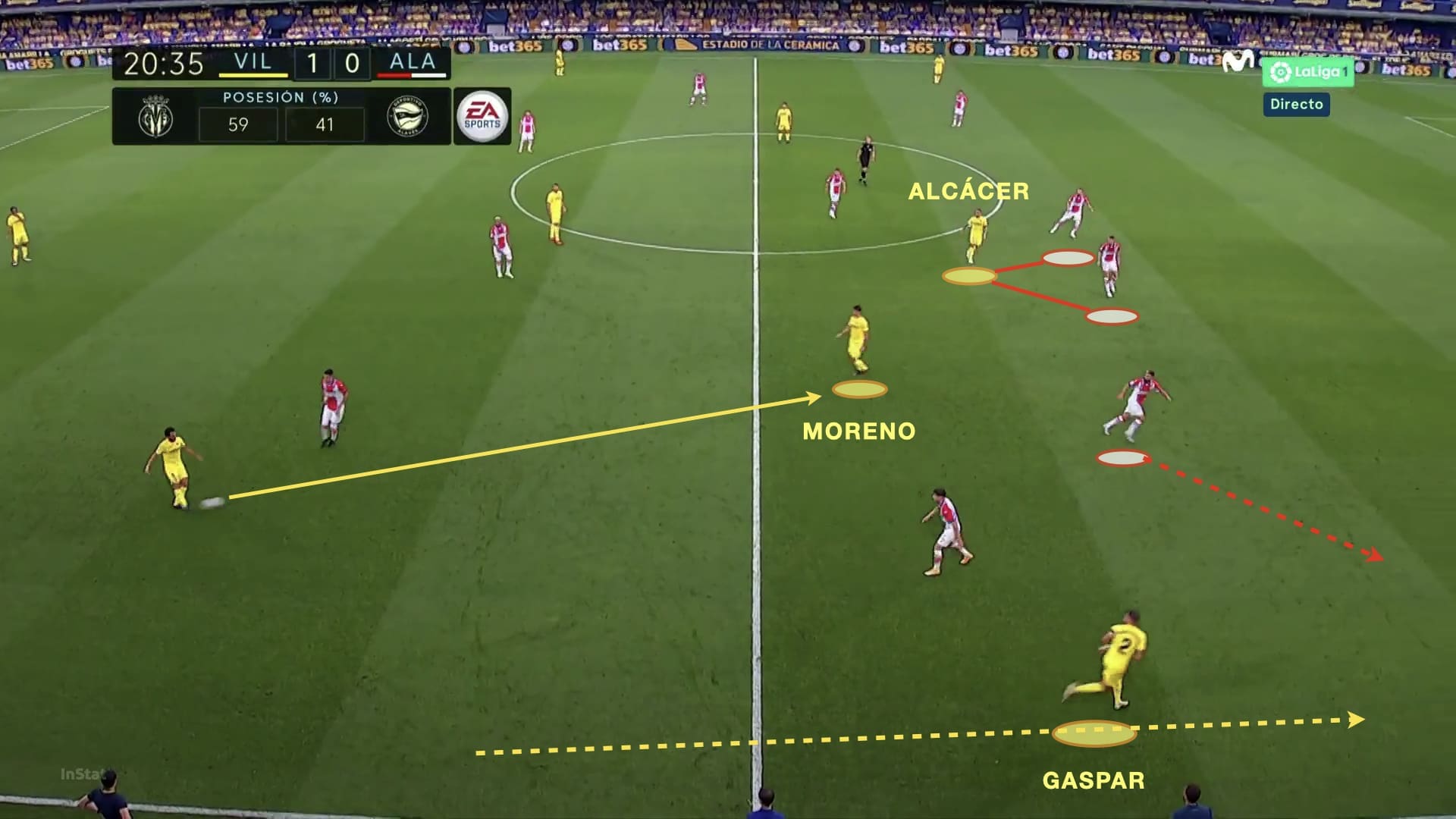
Then, a few seconds later and after a simple one-two, Moreno cuts inside and Trigueros, one of the central midfielders, starts a run in behind. Moreno spots him and has the quality and vision to make a perfectly timed and weighted pass over the defence, but Trigueros doesn’t control the ball well. In these two pictures, we have seen how important is for Moreno that his teammates make the appropriate movements and how he can generate advantages if that happens.
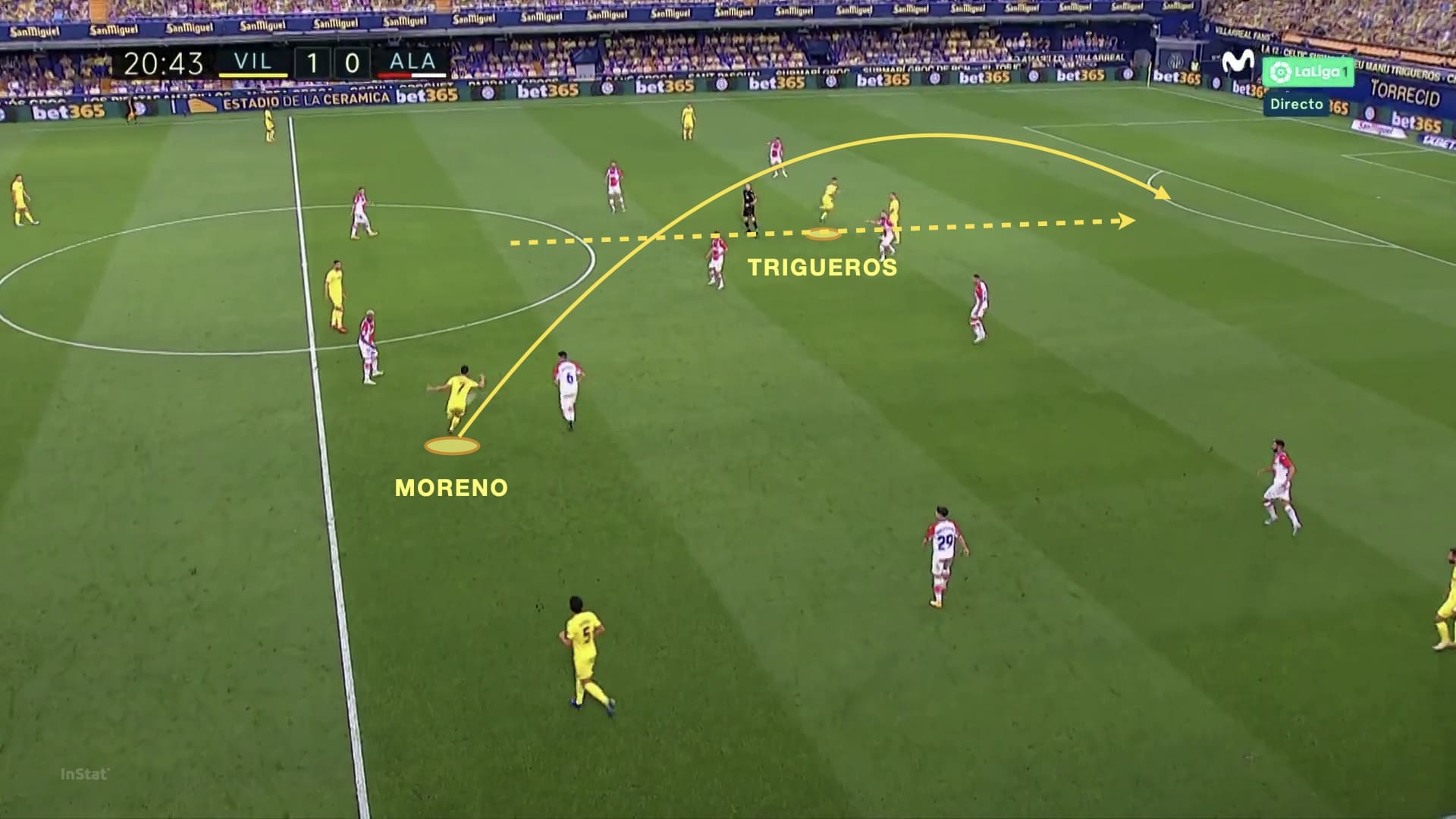
Moreno has the quality to create danger with his passes and dribbles from the second line. He ranks 17th between the attackers in terms of progressive passes with (4.64 per 90) and 10th in offensive duels (14.25 per 90). His wide range of action and his willingness to take risks (he also has 4.64 dribbles and 1.66 progressive runs per 90) combined with his quality make him an all-around threat.
The next two graphs are very revealing about Moreno’s ability to create in the final third, either by putting the ball into the penalty box or dribbling in the final third. First, we see his penalty area deliveries in the last calendar year. It strikers how he can put the ball into the box with ease either carrying it, passing or crosses, and also how effective he is in turning these deliveries into goal opportunities (key passes).
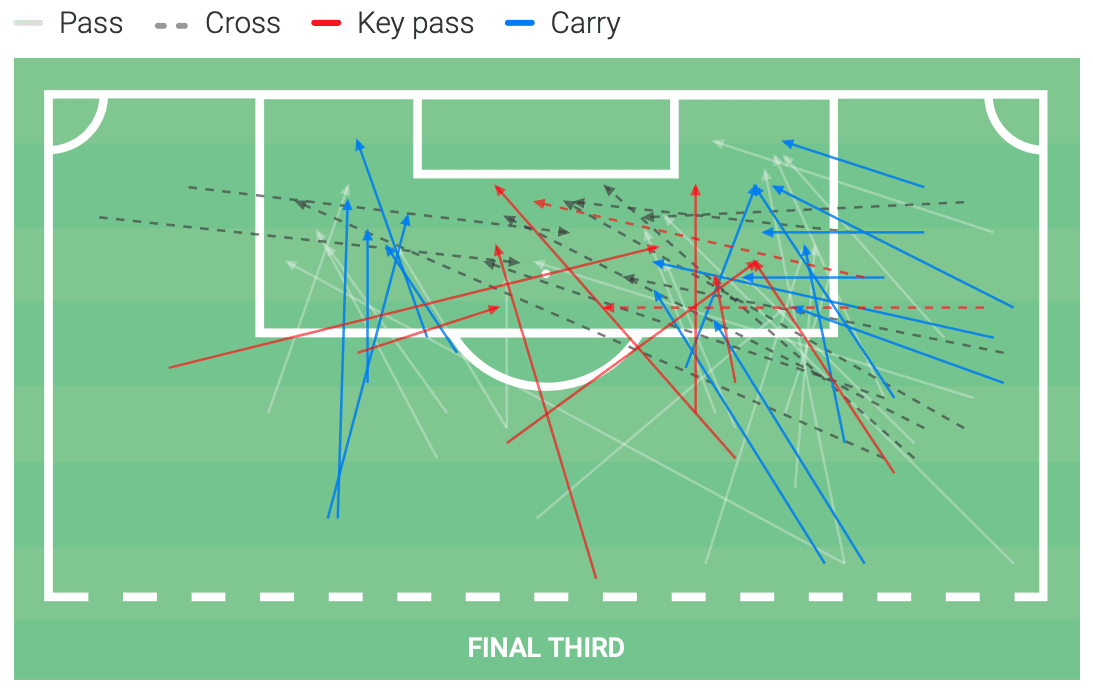
And in this second picture, we see Moreno’s dribbles in the final third in the last calendar year. He concentrates them on the right side so he can cut inside and use his best foot. But apart from how good he’s at dribbling and keeping possession, here we see how direct Moreno can be as lots of his dribbles end up in shots and goals.
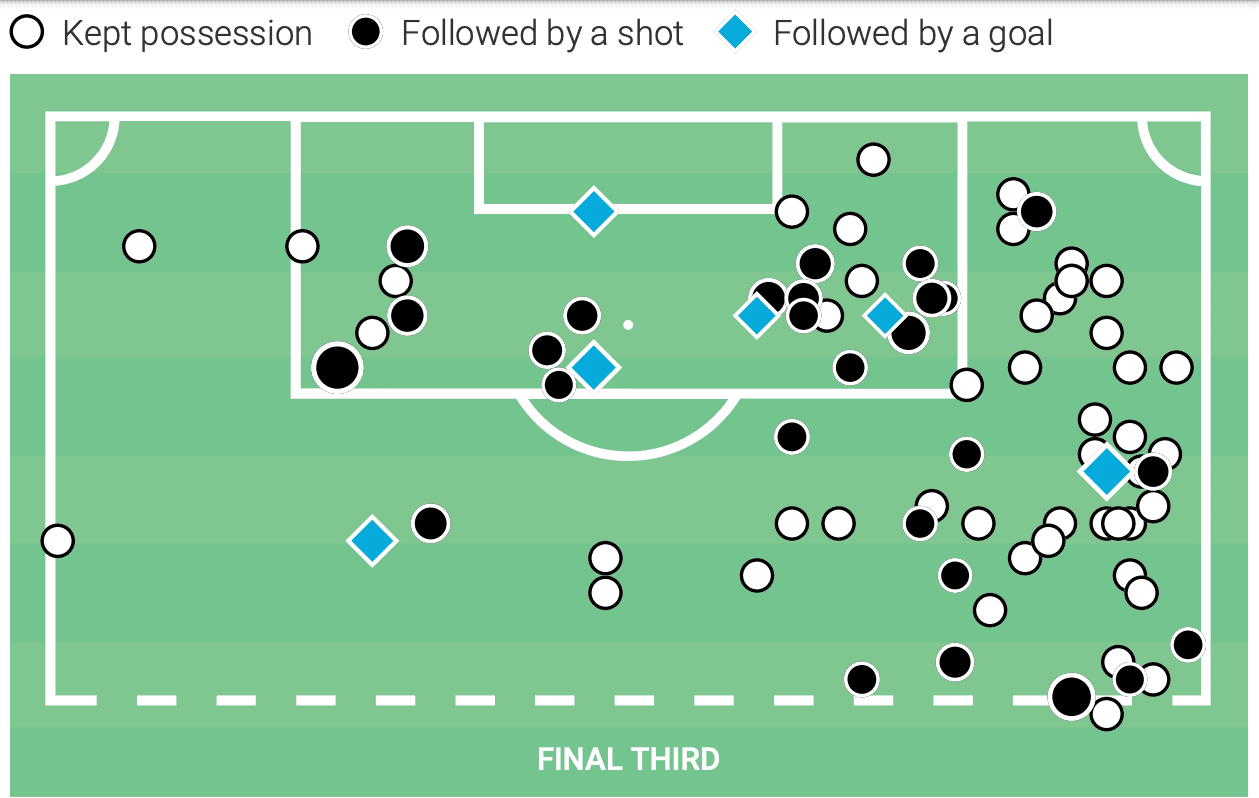
Finally, when it comes to his scoring ability, Moreno is again an outstanding player. He prefers to make late runs into the box or stay at the far post than making runs in behind, but these movements are very effective. Morenos is the ninth player with the most touches inside the box per 90 between La Liga attackers with 5.14, turning a majority of those touches into dangerous shots (2.65 shots per 90 with an average of 0.17 xG per shot).
Below we can see Moreno’s shot map from the last 365 days. He usually shoots from inside the box and he prefers mostly central positions but can do it from both sides and find the goal very often (41.8% of his shots are on target and his conversion rate is 19.8%). Once near the goal, Moreno is really intelligent and can find spaces inside the six-yard box or anywhere across the penalty box with ease.
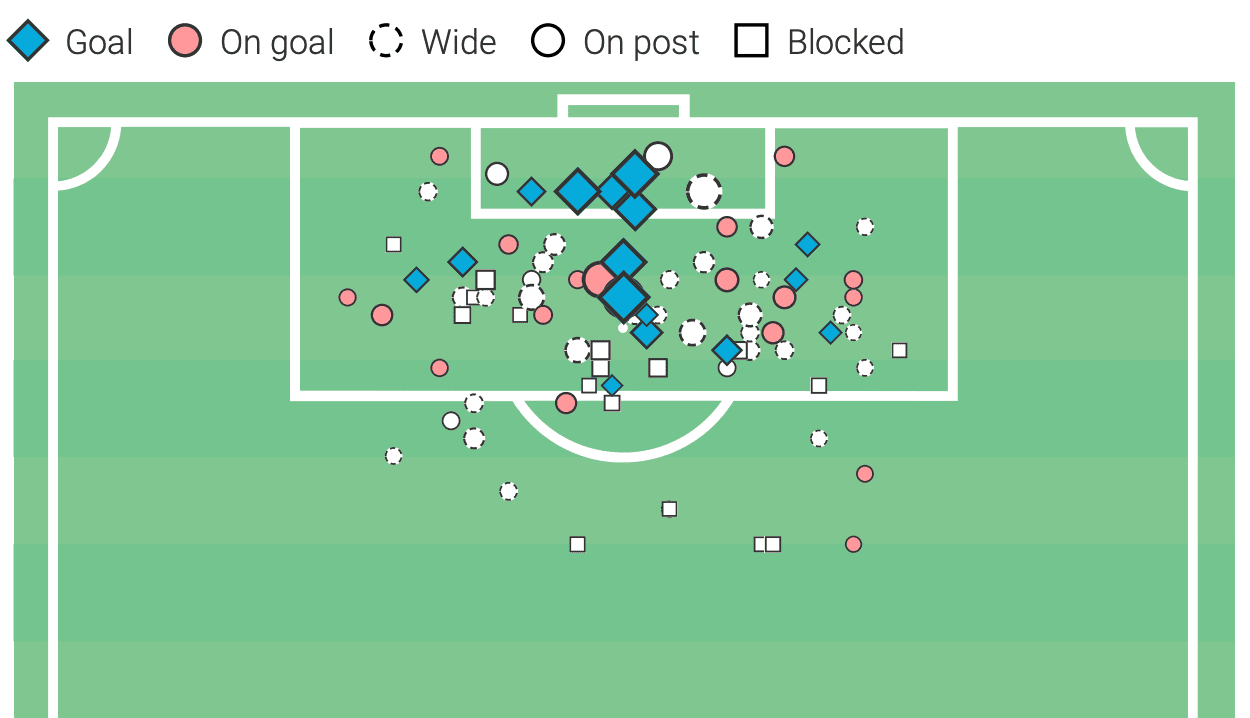
Let’s see a couple of examples of Moreno’s movements inside the box. In this first picture, we can see one of his characteristical late runs into the box. While his attacking partner makes a quick run and ends up around the penalty spot attracting the attention of the centre-backs, Moreno stays behind and only accelerates when the right-back has dribbled his marker, ending up unmarked at the edge of the box. He gest the low cross but can finish correctly. This run is a matter of timing and doesn’t have anything to do with pace, showing how intelligent Moreno is.
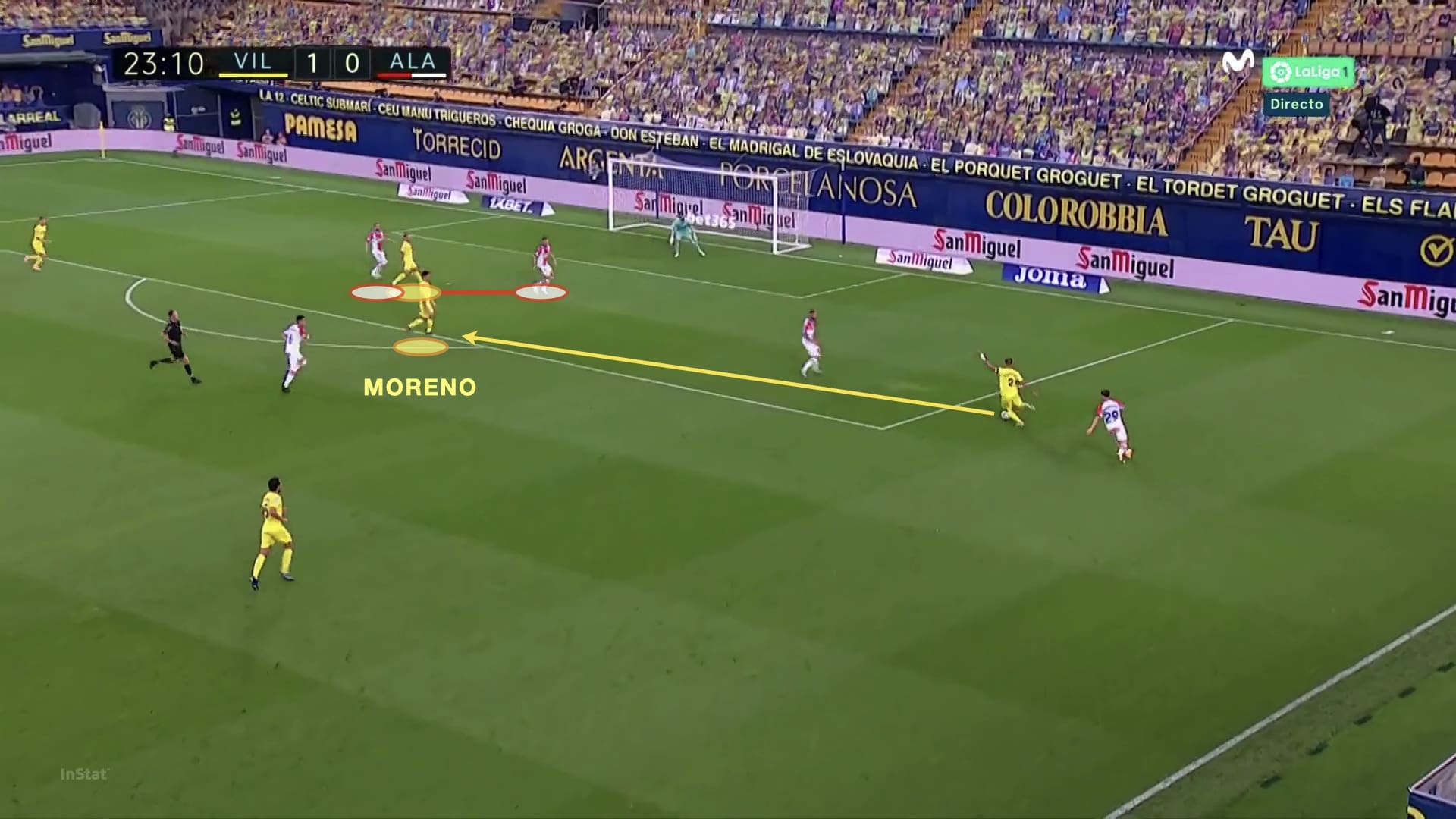
And in this second picture, we see one of his runs into the second post against Atletico Madrid. The play is happening on the left side of the pitch and one of Moreno’s teammate is already in a central position attracting the defenders, so Moreno moves into the far post and asks for the ball. He receives unmarked and his shot goes slightly wide.
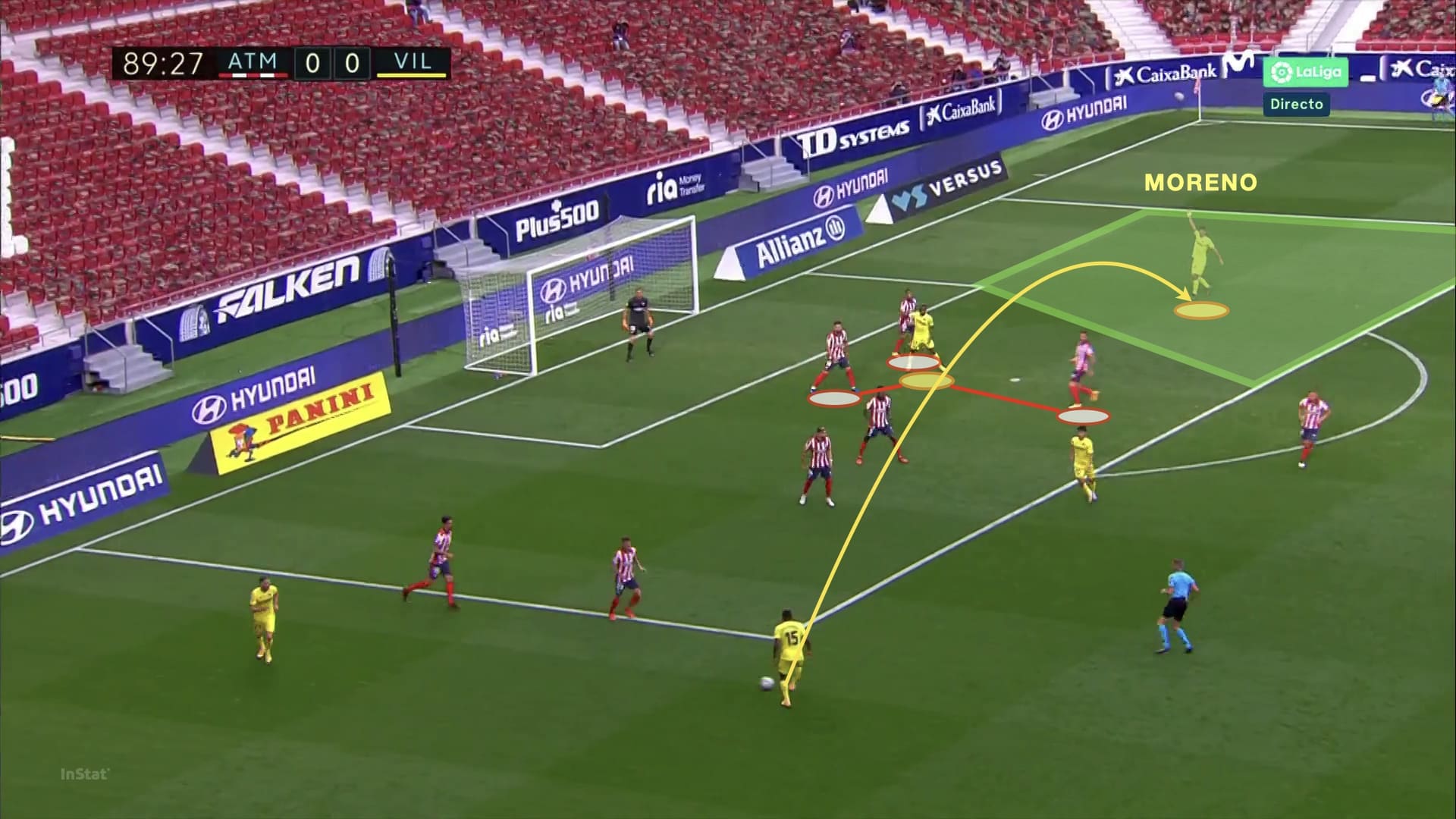
In this part of the scout report, we have seen the most attacking part of Moreno’s game. He adds scoring instinct and good movements in and around the box to his ability as a playmaker, becoming a total attacker. If using Total Football Analysis’ xGold we look for similar players to Moreno based on statistics, we get results like Dries Mertens, Alassane Pléa or Iago Aspas, great goalscorers all of them but also with excellent ball-playing abilities and capable of playing from the wings and as a striker.
Conclusion
Moreno has started this season in the mood he finished the last one. Emery has understood how important he is for the team and his teammates are starting to do what they need to make him comfortable and take advantage of his quality. If Villarreal want to be in the top positions in La Liga and reach the UEFA Champions League they’ll need to make the best out of arguably their best player and they seem to know that.
Aged 28, Moreno has entered his peak and has the maturity to be a consistent performer both for team and nation. He may be a little bit old for a big movement, but if he continues in the form he has been for the last 18 months he will be surely be considered an immediate-impact option by some of the biggest clubs in the continent.





Comments